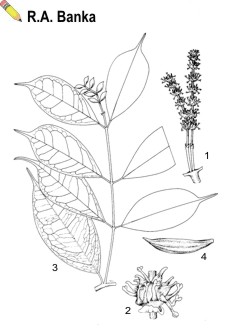Record Number
1510
PROSEA Handbook Number
2: Edible fruits and nuts
Taxon
Gnetum costatum K. Schumann
Protologue
Fl. Kais. Wilh. Land: 13 (1889).
Family
GNETACEAE
Chromosome Numbers
2n = unknown
Vernacular Names
There are over 700 different vernacular names in Papua New Guinea. The most commonly spoken language (Pidgin) refers to the species as 'tulip', which is the name given to all Gnetum species, i.e. also Gnetum gnemon L. and Gnetum bosavicum F. Markgraf.
Origin and Geographic Distribution
Gnetum costatum is an endemic species in Papua New Guinea and surrounding islands. It occurs from Irian Jaya to Papua New Guinea and reaches east to Bougainville and the Solomon Islands. It is most common in New Guinea.
Uses
Fruits, often with the leaves and inflorescences (both male and female) are boiled with other vegetables together in one pot and served. The fruits require a longer time to boil than those of Gnetum gnemon in order to remove the bitter taste. Coconut milk is normally added to improve the taste.
The inner bark provides a fibre which is used for making string bags known as 'bilum'. A similar fibre is also extracted from other Gnetum species, that of Gnetum gnemon being most commonly used. The wood is of no commercial value.
The inner bark provides a fibre which is used for making string bags known as 'bilum'. A similar fibre is also extracted from other Gnetum species, that of Gnetum gnemon being most commonly used. The wood is of no commercial value.
Properties
The kernels, leaves and inflorescences are nutritious since they contain starch (40—45%) and protein (8—10%).
Botany
Dioecious tree, 15—20 m tall; bark reddish-brown outside, tan inside. Leaves obovate to elliptical, 15—18 cm long, thin, slightly thicker than in Gnetum gnemon, yellowish when dry, tapering at both ends, petiole 0.5 cm, secondary nerves bent, joining. Male inflorescences solitary, axillary, simple, yellowish, 6—7 cm long, whorls with hairs and sessile flowers remote, 3 mm broad, male flowers with tender long-exserted sporophyll (stamen), female flowers sterile, ovate, beaked, finely whitish pubescent, up to 10 in a ring. Female inflorescences similar, their flowers immersed in dense whitish hairs, flowers long-acuminate, finely whitish pubescent. Fruit nut-like, obliquely-fusiform, 4 cm x 1 cm, red or pink, tapering at base, acuminate at top, its outer envelope thin, fleshy, showing the longitudinal ribs of the hard middle envelope when dry. Seed fusiform, furrowed.
Image
 | Gnetum costatum K. Schumann - 1, male inflorescences; 2, part of male inflorescence; 3, fruiting branch; 4, fruit |
Ecology
The tree occurs in rain forests at altitudes up to 1350 m. It is common on ridge tops, along or near river banks and also in secondary or disturbed forest. In New Guinea the species is commonly found in mixed forest of Lithocarpus, Anisoptera and Hopea species. It does not occur in swamps or in areas with a high water table. Areas experiencing both wet and dry seasons seem to be ideal for the species.
Harvesting
The species occurs wild in the forest from where fruits, leaves and inflorescences are collected. It is not cultivated as a crop.
The time of harvest or gathering of fruits is normally from March to July. Young leaves can be picked at almost any time of the year.
The time of harvest or gathering of fruits is normally from March to July. Young leaves can be picked at almost any time of the year.
Prospects
Being one of the species used locally in New Guinea with almost no commercial value, very little is known about its potential. It is an important source of food and fibre for local people. More research is needed on the botanical, agricultural and economic aspects.
Literature
Markgraf, F., 1951. Gnetaceae. In: van Steenis, C.G.G.J. (Editor): Flora Malesiana, Series 1. Vol. 4. pp. 336, 341.
Author(s)
R.A. Banka
Correct Citation of this Article
Banka, R.A., 1991. Gnetum costatum K. Schumann. In: Verheij, E.W.M. and Coronel, R.E. (Editors): Plant Resources of South-East Asia No 2: Edible fruits and nuts. PROSEA Foundation, Bogor, Indonesia. Database record: prota4u.org/prosea

All texts are licensed under a Creative Commons Attribution-Noncommercial-Share Alike 3.0 Netherlands License
This license does not include the illustrations (Maps,drawings,pictures); these remain all under copyright.